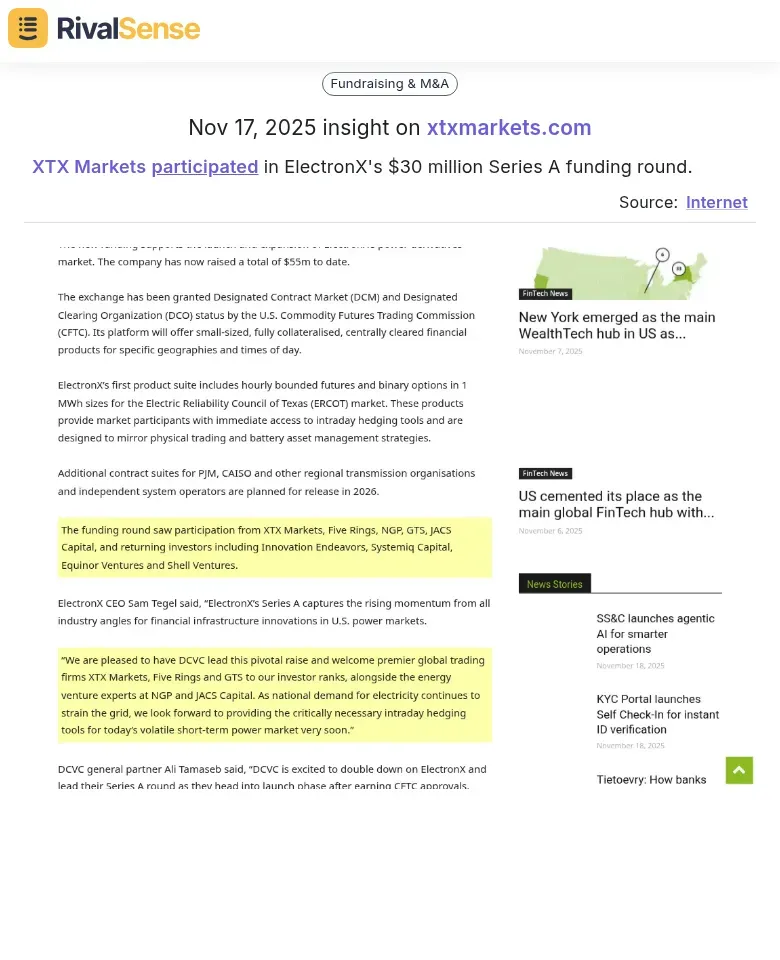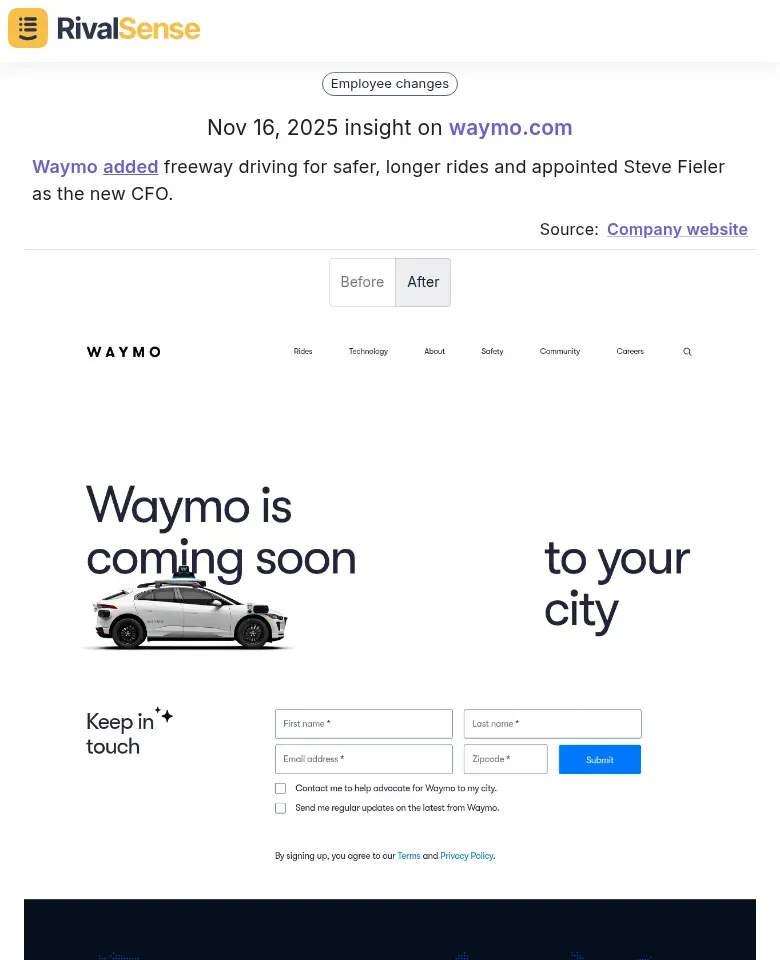Track Key Account Feedback: A Practical Guide for B2B Leaders
November 18, 2025
RivalSense Team
CONTENTS
- Why Key Account Feedback Matters
- Types of Key Account Feedback
- Steps to Track Key Account Feedback
- Tools for Tracking Key Account Feedback
- Integrating Feedback with Competitive Intelligence
- Actionable Tips and Checklist
- Conclusion
- FAQs
Why Key Account Feedback Matters
Key accounts are the lifeblood of B2B companies—they drive revenue, provide valuable referrals, and offer insights that can shape your product roadmap. Yet, many businesses struggle to systematically track and act on feedback from these crucial relationships. Understanding and leveraging this feedback is essential for sustaining growth and maintaining a competitive edge in today's dynamic market.
When you track key account feedback effectively, you can:
- Prevent churn by addressing issues before they escalate
- Identify upsell opportunities based on expressed needs
- Improve product-market fit by understanding what your most valuable customers truly want
- Strengthen relationships through proactive engagement
Types of Key Account Feedback
Gathering feedback from key accounts involves multiple dimensions, each offering unique insights. By categorizing feedback into distinct types, you can tailor your collection methods and derive more actionable intelligence. This structured approach ensures you capture both explicit and implicit signals from your most important clients.
🗣️ 1. Direct Feedback
- Structured surveys: NPS, CSAT, CES surveys tailored for key accounts
- Account reviews: Quarterly business reviews (QBRs) and strategic planning sessions
- Executive conversations: C-level feedback from your champions
📊 2. Behavioral Feedback
- Usage patterns: How key accounts actually use your product
- Feature adoption: Which capabilities they leverage most
- Support interactions: Frequency and nature of support requests
🌐 3. External Signals
- Social media mentions: What they're saying publicly about your brand
- Review site activity: G2, Capterra, Trustpilot reviews
- Competitive comparisons: When they mention or evaluate alternatives
Steps to Track Key Account Feedback
Implementing a systematic process for tracking key account feedback ensures consistency and maximizes the value of insights gathered. A step-by-step approach helps in organizing data, identifying trends, and driving meaningful actions. Let's break down the essential steps to build an effective feedback tracking system.
Step 1: Map Your Key Account Touchpoints
Create a comprehensive map of all interactions with each key account:
- Sales conversations
- Customer success check-ins
- Support tickets
- Product usage data
- Executive business reviews
- Social media interactions
Practical tip: Use a CRM to track all touchpoints and assign ownership for follow-up.
Step 2: Implement Structured Feedback Collection
- Quarterly surveys: Send targeted NPS or CSAT surveys to key decision-makers
- In-app feedback: Use tools like Userpilot to gather contextual feedback during product usage
- Executive interviews: Schedule regular 1:1s with champion contacts
✅ Checklist for effective feedback collection:
- [ ] Define clear objectives for each feedback channel
- [ ] Ensure feedback is timely and contextual
- [ ] Make it easy for customers to provide feedback
- [ ] Respect their time with concise, focused questions
Step 3: Centralize and Analyze Feedback
Don't let feedback live in silos. Consolidate insights from:
- Survey tools (SurveyMonkey, Typeform)
- CRM notes (Salesforce, HubSpot)
- Support systems (Zendesk, Intercom)
- Product analytics (Mixpanel, FullStory)
- Social listening tools (Brandwatch, Mention)
Practical advice: Create a "key account insights" dashboard that aggregates all feedback sources for each account.
Step 4: Act and Close the Loop
Feedback without action damages trust. Implement a clear process:
- Categorize feedback by urgency and impact
- Assign ownership to relevant teams
- Set response timelines (24 hours for urgent issues)
- Follow up with customers to show you've listened
Tools for Tracking Key Account Feedback
Selecting the right tools is crucial for efficiently gathering, analyzing, and acting on key account feedback. The market offers a variety of solutions tailored to different aspects of feedback tracking, from direct surveys to behavioral analytics. Investing in the appropriate tools can streamline your processes and enhance data accuracy.
| Tool Category | Examples | Key Features |
|---|---|---|
| Survey and Direct Feedback | Userpilot, SurveyMonkey, Typeform | In-app surveys, structured forms, engaging interfaces |
| Behavioral Analytics | Mixpanel, FullStory, Hotjar | User behavior tracking, session replays, heatmaps |
| Social Listening and External Monitoring | Brandwatch, Mention, Sprout Social | AI-powered intelligence, competitor tracking, unified management |
Integrating Feedback with Competitive Intelligence
Tracking key account feedback becomes even more powerful when combined with competitive intelligence. While you're gathering insights from your customers, it's equally important to understand what's happening in your competitive landscape. This holistic approach allows you to contextualize feedback, anticipate market shifts, and make informed strategic decisions.
This is where RivalSense adds strategic value: Our platform tracks competitor movements across 80+ sources—including product launches, pricing changes, event participation, partnerships, and media mentions—delivering comprehensive weekly reports. When you combine your key account feedback with intelligence about competitor activities, you can:
- Identify competitive threats mentioned by your accounts
- Benchmark your performance against competitor updates
- Spot market trends before they become obvious
- Make data-driven decisions about product roadmap priorities
Here are real examples of competitor insights tracked by RivalSense and why they matter for your business strategy:
-
Product Investment Insight: Tradeprint operations director Rod Scrimgeour announced on November 17 that the company is installing its first inkjet web press, a Canon ProStream 3133, early next year as part of a £3 million investment to boost capacity and efficiency.

Why it matters: Tracking such product launches helps you anticipate competitor innovations, assess potential market disruptions, and align your own investments to maintain competitiveness. -
Partnership and Funding Insight: XTX Markets participated in ElectronX's $30 million Series A funding round.

Why it matters: Monitoring partnerships and funding activities reveals strategic moves that could influence industry dynamics, helping you identify collaboration opportunities or competitive pressures affecting your key accounts. -
Product Update and Management Change Insight: Waymo added freeway driving for safer, longer rides and appointed Steve Fieler as the new CFO.

Why it matters: Keeping tabs on product enhancements and executive changes provides insights into competitor priorities and potential strategic shifts, enabling you to proactively address customer concerns or highlight your differentiators.
Practical integration tip: Create a monthly review process where you analyze key account feedback alongside RivalSense competitor intelligence reports to identify patterns and opportunities.
Actionable Tips and Checklist
Implementing a robust feedback tracking system requires ongoing effort and optimization. By focusing on quick wins and establishing comprehensive processes, you can ensure that feedback drives continuous improvement. Here are some practical tips to get started and a checklist to guide your efforts.
🚀 Quick Wins to Implement Today
- Set up automated survey triggers for key account milestones
- Create a "voice of customer" channel in your team's communication platform
- Establish a monthly feedback review with your leadership team
- Track competitor mentions in key account conversations
✅ Comprehensive Tracking Checklist
- [ ] Map all key account touchpoints
- [ ] Implement structured feedback collection
- [ ] Centralize feedback from all sources
- [ ] Establish clear action and follow-up processes
- [ ] Integrate competitive intelligence (consider RivalSense for comprehensive competitor tracking)
- [ ] Create accountability for feedback implementation
- [ ] Measure the impact of feedback-driven changes
- [ ] Regularly review and optimize your feedback system
Conclusion
Tracking key account feedback isn't just about collecting data—it's about building stronger relationships, driving product innovation, and staying ahead of competitors. By implementing a systematic approach that combines direct customer insights with competitive intelligence, you can transform feedback into strategic advantage. Consistent effort in this area will pay dividends in customer loyalty and market positioning.
Remember: The most successful B2B companies don't just listen to their key accounts; they act on what they hear and use those insights to outmaneuver competitors.
FAQs
What's the most common mistake in tracking key account feedback?
The biggest mistake is collecting feedback but failing to act on it or close the loop with customers. This damages trust and makes future feedback less valuable.
How often should we survey key accounts?
Quarterly surveys work well for most B2B relationships, supplemented by ongoing in-app feedback and regular check-ins with customer success managers.
Can we track key account feedback without expensive tools?
Yes, start with spreadsheets and manual processes, but as you scale, dedicated tools will save time and provide more comprehensive insights. The key is consistency in collection and action.
How does competitive intelligence enhance key account feedback?
Competitive context helps you understand whether feedback reflects market trends or specific competitor advantages, enabling more strategic decision-making about product investments and positioning.
Ready to take your key account feedback to the next level? Try RivalSense for free at https://rivalsense.co/ to gain comprehensive competitor insights and get your first competitor report today!
📚 Read more
👉 Cold Chain Logistics Competitor Financial Analysis: Essential Templates and Frameworks
👉 How Microsoft's Visual Studio 2026 Uncovered a Rival's Growth Strategy
👉 Competitor Insights: Boost Key Account Win Rate
👉 Advanced Key Account Tracking Tactics for IoT Operations Leaders
👉 Leverage Media Mentions for Competitive Content Strategy Wins
